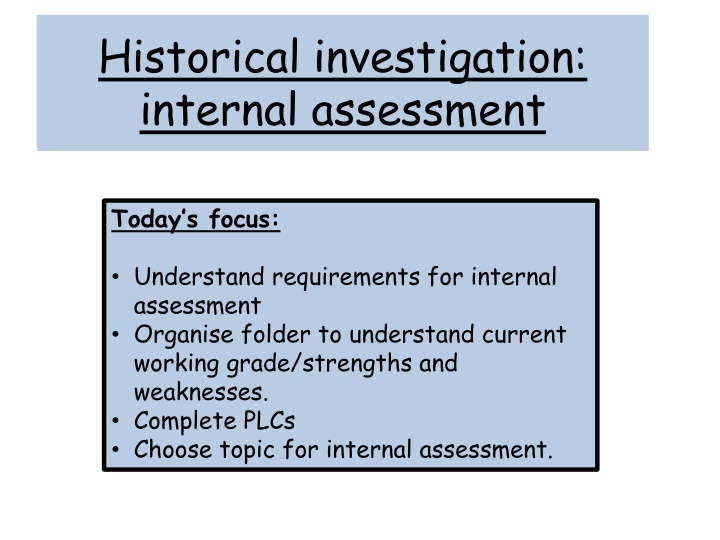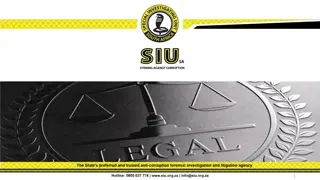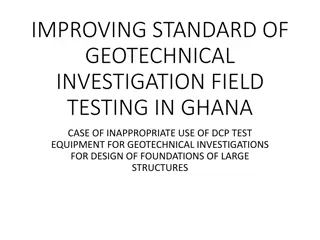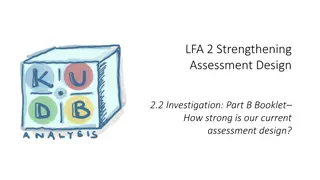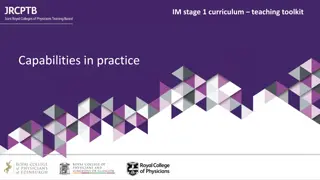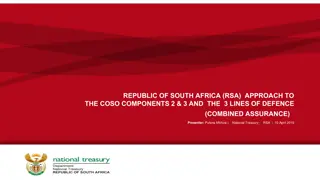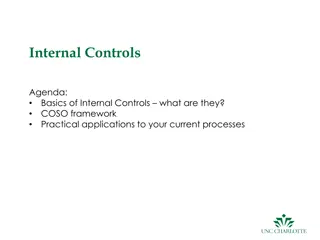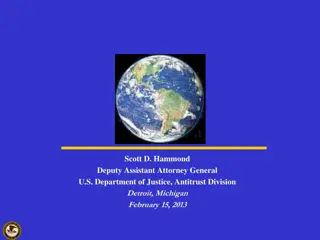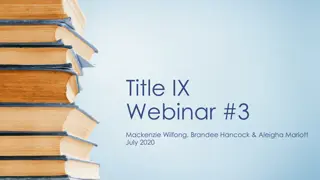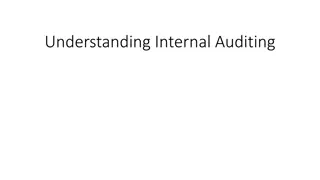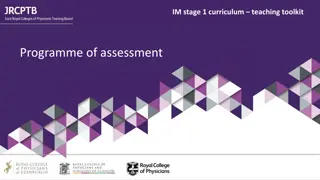Requirements for Historical Investigation Internal Assessment
Understand the 25% weightage internal assessment comprising 3 sections for a historical investigation. Focus on source evaluation, investigation, and reflection within a 2,200-word limit. Choose a historical topic, analyze primary and secondary sources, and consider causation, consequence, continuity, change, and significance in your investigation. Select a topic like Jack the Ripper, Nazi Germany, or Norman England, ensuring it's historical and engaging. Follow suggested word allocations, and seek approval for your chosen topic and investigation question before commencing work.
Download Presentation

Please find below an Image/Link to download the presentation.
The content on the website is provided AS IS for your information and personal use only. It may not be sold, licensed, or shared on other websites without obtaining consent from the author.If you encounter any issues during the download, it is possible that the publisher has removed the file from their server.
You are allowed to download the files provided on this website for personal or commercial use, subject to the condition that they are used lawfully. All files are the property of their respective owners.
The content on the website is provided AS IS for your information and personal use only. It may not be sold, licensed, or shared on other websites without obtaining consent from the author.
E N D
Presentation Transcript
Historical investigation: internal assessment Today s focus: Understand requirements for internal assessment Organise folder to understand current working grade/strengths and weaknesses. Complete PLCs Choose topic for internal assessment.
You must complete a historical investigation of your choice. The Internal assessment is worth 25% of your final grade. It is made up of 3 sections You must not exceed 2,200 words You must include a bibliography referenced correctly. 1. Identification and evaluation of sources 3. Reflection 2. Investigation
Suggested allocations for each section of the historical investigation. Stick this in and make sure you use this to help you when you start writing your assessment! 1. Identification and evaluation of sources 2. Investigation 3. Reflection Total: 500 words 1,300 words 400 words 2,200 words
Choosing your topic Choose something that interests you It must be historical it can not be an event that has happened in the last 10 years. You must get approval of topic and question for investigation before work is started. You will be expected to select and analyse a range of sources and consider diverse perspectives. You must search for, select, evaluate and use evidence to reach relevant conclusions consistent with the evidence and arguments that have been put forward.
Think of topics you have covered and enjoyed Jack the Ripper Prisons in England Types of punishments in medieval England Nazi Germany Rise of Hitler Cold War Stalin Norman England Slavery
Primary sources: written at the time in question. Secondary sources written after time in question. Section 1: Identification and evaluation of sources /6 You must analyse in detail two of the sources that you will use in your investigation. They can be primary or secondary sources. Hint: You must: You must have an appropriate question to investigate. Consider the following to help you: Clearly state the question you have chosen to investigate (must be stated as a question) Include a brief nature of the two sources selected for detailed analysis, including an explanation of why they are relevant. Analyse two source in detail. With reference to Origin, Purpose and content. You should analyse the value and limitations of the two sources in relation to the investigation. Causation Consequence Continuity Change Significance
Examples of questions How significant were the economic problems as caused by the Bamberg Witch Trials (1923-33) To what extent was weak leadership responsible for the collapse of the Egyptian Old Kingdom in 2125 BC? You questions must open up a debate!
Section 2: Investigation /15 This is the actual assessment. It must be clearly and effectively organised. Must contain critical analysis that focuses on the question. It must include a conclusion. Primary or secondary sources may be used (you can mixture of the two).
A BREAKDOWN OF THE MARKING CRITERION: HOW TO ACHIEVE 13-15Writing is CLEAR (language must be tight)and COHERENT (well-reasoned) You have used LOGICAL, TIGHT structure that advances the investigation toward your conclusion You have conducted ON-GOING CRITICAL ANALYSIS of the topic (investigation) and your sources The investigation (essay) is FOCUSED on the RESEARCH QUESTION (not a wandering undisciplined discussion) Evidence from a RANGE of sources has been USED [this requires more than name dropping, or the insertion of convenient quotes, you need to CRITICALLY ANALYSE all sources, demonstrating HOW they support the argument you are making.] You have included varying PERSPECTIVES - ie. different schools of historical thought, different time periods/contexts. Your essay has built toward a reasoned and well-argued, well- evidenced CONCLUSION.
Structuring the Essay Introduction: Provide a couple of sentences of context that introduce the reader to the content of the investigation. Itemise the main issues that will be addressed in each of the main body paragraphs to follow. Introduce areas of contestation that the essay will address. Give a sense of the main argument or the thesis that you will develop throughout the essay. Main body paragraphs: Each aspect of the response should be developed in a paragraph. Conventionally there will be three or four aspects/main body paragraphs Each aspect should be introduced through a topic sentence. It should be explained using historical evidence. The more specific the detail the better. Sophisticated responses will refer to perspectives and show developed understandings of schools of thought that are relevant to the research question. Conclusion: Approximate word count for a conclusion: There is no clear rule about this, but try to get between 50-150 words, to ensure a few things: That your conclusion is not a huge paragraph of new material that should have been in your body paragraphs. That you allow yourself enough scope to weigh the arguments you posed and evaluated in your investigation and reach a reasoned conclusion.
Approximate word count for a conclusion: There is no clear rule about this, but try to get between 50-150 words, to ensure a few things: That your conclusion is not a huge paragraph of new material that should have been in your body paragraphs. That you allow yourself enough scope to weigh the arguments you posed and evaluated in your investigation and reach a reasoned conclusion. Here you draw the ideas and information together. Many essay topics offer a quote to ask you to make a judgement, so this is where you do that (as long as it flows from the body of your essay. The question often uses phrases like: How far do you agree that... , To what extent is ittrue/accurate . , evaluate the accuracy of This means that you are deliberately re-stating the contention of your investigation (your answer to the research question you made), and re-summarising the arguments you made in each body paragraph to discuss the question. You must do this in your conclusion just like you did in your introduction. A good way to ensure that you remain relevant to the ends is to make your final statement a further reworking of the question: e.g. While economic factors definitely influenced the crisis, it was clearly the political considerations which were at the base of the events which unfolded in. You need to ensure that you are using a concluding tone , which means that you are using words and phrases like: E.g: Therefore there were many factors that contributed to the making of a revolutionary situation in Russia by February 1917 The writing will be in past tense, and talk about the rest of the essay s content as though it has already been discussed (which it should be :) )
Section 3: Reflection /25 The section of the internal assessment task requires you to reflect on what undertaking your investigation highlighted. What methods used by the historian did you use in your investigation? What did your investigation highlight to you about the limitations of those methods? What are the challenges facing the historian? How can the reliability of the sources be evaluated?
Assessment Criteria for Section 3 0 The work does not reach a standard described by the descriptors below. 1 2The reflection contains some discussion of what the investigation highlighted to the student about the methods used by the historian. The reflection demonstrates little awareness of the challenges facing the historian and/or the limitations of the methods used by the historian. The connection between the reflection and the rest of the investigation is implied, but is not explicit. 3 4The reflection is clearly focused on what the investigation highlighted to the student about the methods used by the historian The reflection demonstrates clear awareness of challenges facing the historian and/or limitations of the methods used by the historian. There is a clear and explicit connection between the reflection and the rest of the investigation.
Referencing your sources plagiarism: The representation, intentionally or unwittingly, of the ideas, words or work of another person without proper, clear and explicit acknowledgment.
Accurate and thorough referencing is paramount to a successful History IA. Referencing is a system that allows you to acknowledge the contributions of others in your writing. Whenever you use ANY words, ideas or information from ANY source in your work, you must reference those sources. This means that if you use the exact words of an author, if you paraphrase their words or if you summarise their ideas, you must provide a reference. Not referencing your sources means you may be charged with plagiarism and your work could be failed.
The MLA and APA styles require you to use in-text citations, which are citations placed in parentheses within the body of your paper. For example (Surname, 2013). Common in-text citation formats are MLA (Modern Language Association) style; which is primarily used for papers in the humanities; APA (American Psychological Association) style, which is primary used for papers in the social sciences. (Source) These styles are similar to Harvard referencing.
Conducting academic research The Internal Assessment requires independent and academic research in to a topic that interests you. Your first port of call should be your school library, your local library or a university library because there is no substitute for a book written by an historian. Be mindful when using online sources. For your IA, you should only use reputable and authoritative sources. Some online sources fit that bill but always be judicious and critical in using websites. That doesn't mean that you can't cite online material, you just have to critically evaluate the websites that you do use. You can read Wikipedia articles but never ever ever ever ever cite Wikipedia in your IA. If the information on Wikipedia is good, look at the original sources and references at the bottom of the article and locate those sources in the library and online. Check the info, ensure that the source is reliable, cross check the information and then cite the original info. Your key information should come from reputable books and peer reviewed academic articles. What you need to find:Look for a broad range of relevant, authoritative sources which help you answer your research question. Aim for a minimum of 6 - 8 high quality sources. You will evaluate two significant sources in Section 1. These two have to be central to your argument and you should be able to explain why that is so. It is preferable to have two contrasting sources: Preferably two opposing view points and or/one primary / one secondary.
What does this look like ? Sample A: To what extent did World War II lead to women in United States becoming permanent participants of the labor force? Section 1: Identification and Evaluation of sources This investigation will explore the question: To what extent did World War II lead to women in the United States becoming permanent participants of the labour force? The years 1940 to 1950 will be the focus of this investigation, to allow for an analysis of women s employment during the war, as well as its evolution in the post-war period. The first source which will be evaluated in depth is Julia Kirk Blackwelder sbook The Feminization of Work in the United States, 1900-1995 , written in 1997. The origin of this source is valuable because Blackwelder is a professor of history at Texas University, specializing in Modern US and American women s history, and has written extensively on women s employment in scholarly journals and books, indicating that she is knowledgeable on this topic. Furthermore, the date of the publication of this source, 1997, strengthens its value, as it indicates that Blackwelder, benefitting from hindsight, has been able to analyze a comprehensive range of sources, including government documents, interviews and statistics. However, the origin of the source is limited in that Blackwelder is not a professional expert in economics, with which this topic is closely related and, consequently, might have misinterpreted some of the economic data presented. The purpose of Blackwelder s book is to analyze the trends of American women s employment in the 1900-1955 period, and to let evidence speak for itself (Blackwelder xiii). This is valuable, for it indicates that an extended period of time has been examined, permitting for connections to be made between the trends discovered. However, the fact that the author has covered nearly a century of economic developments limits its value to a historian studying economic developments within a short time period. The second source evaluated in depth is Mary Anderson s 1944 address American Economic Association The Postwar role of American women , which was delivered in March, 1944. The origin of this source is valuable because the address was delivered by the head of the Women s Bureau of the Department of Labor, and therefore provides an insight into the views of a well-known figure regarding women s employment and post-war plans. Additionally, the date of delivery of the address, 1944, indicates that the source allows for a valuable understanding of contemporary views on women s employment. However, this date is also a limitation, for it suggests that the source, having been written before the completion of the war, is likely to fail to analyze extensive research on women s employment. In terms of origin, the source is also limited in that Anderson was herself a former factory worker and was particularly well attuned to the thinking of female employees (Weatherford 256), indicating that she might have tended to shape the address according to her views, and, consequently, may have provided a slightly subjective insight into government plans. The purpose of this source is to underscore the importance of the adoption of measures to secure the position of women in the American post-war workforce. The address therefore provides a valuable insight into government plans at the time. The source is, however, limitedin its purpose in that the address, having been written to convince others of Anderson s point of view, perhaps omits some inconvenient truths about the government s views, merely describing encouraging plans for female worke
